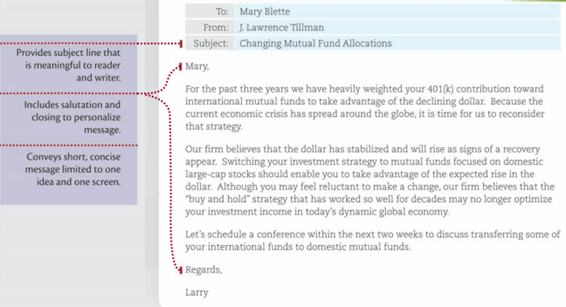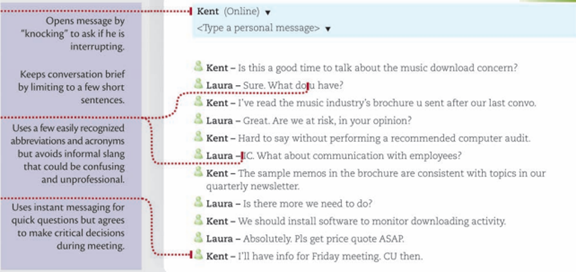Discuss the effective use of email, instant messaging and text messaging in business communication. At the same point in time, what pitfalls and/or practices, should one be sure to steer clear of?
Effective Use of Email
In today’s corporate world, email is an effective tool for communicating with colleagues. While email has a lot of benefits in terms of speed and convenience, it may also cause difficulties if it’s used incorrectly (Carol M. Lehman, 2010). Learning basic netiquette and the term for appropriate Internet conduct can help you succeed online. The guidelines below will help you get the most out of your email:
- Promptly check of mail
In most cases, you should get a response to your email within 24 hours. Ignoring colleague communications may sabotage attempts to foster an open, honest, and collaborative workplace. On the other hand, responding every second may suggest that you’re more concerned with your email than with your work (Rentz, 2014).
Figure 1: Good Example of an effective e-mail message (Carol M. Lehman, 2010)
- Don’t add to the influx of emails.
Follow these basic tips to prevent cluttering up the system with unwanted messages:
- Only forward an email from another person with the consent of the original writer.
- If you want to get a personalized answer, never send an email asking for broad action from several people. If everyone shares responsibility, no one will be held accountable(Marty Brounstein, 2010).
- It’s best not to transmit documents that have been formatted. Messages with different fonts, special print characteristics (e.g., bold, italics, etc.) and pictures take longer to download, take up more storage space, and may be illegible on certain machines. Furthermore, improving regular email messages does not help competitive companies achieve their objectives, and workers and clients/customers may resent such a waste of time(Carol M. Lehman, 2010).
- If the full content of the original message isn’t required for context, edit it when replying to an email. Instead, you may cut and paste relevant parts of a reply that you think would assist the recipient to comprehend what you’re saying. Below the original section, you may type short comments in all capitals.
- If you’re job searching or sending a lot of private messages to friends and family, follow the company’s email policy for personal usage and get a private email account.
- Email should be used with care.
For regular problems that don’t need urgent attention, send short, direct communications such as scheduling meetings, giving your supervisor quick updates, or addressing other uncomplicated issues etc.
- When you are angry, don’t send texts.
Because of the lack of nonverbal communication, emails carrying sensitive, highly emotional content may easily be misunderstood (facial expressions, voice tone, and body language). Sending a flame, which is an online phrase for a passionate, sarcastic, and sometimes abusive message or posting, may elicit a retaliatory reaction from the recipient. Emails sent in rage and laced with passion and sarcasm may cause humiliation or even wind up as evidence in a legal case. Before hitting “Send,” read email messages carefully to avoid damaging relationships or exposing yourself to legal responsibility. If you don’t need a response right away, put a passionate message on hold for an hour until you’ve calmed down and given it some consideration (Carol M. Lehman, 2010). When you have to react quickly, you may admit that your response is emotional and not well thought out. Use phrases like “I need to express my fury for a few lines” or “flame on—I’m writing in anger” to provide this warning (Rentz, 2014).
- Email viruses and hoaxes should be avoided at all costs.
The difficulties created by lethal viruses that destroy data files or irritating messages that just waste your time while they are running may be avoided with a little bit of protection. Install antivirus software that will check your hard drive every time you turn on your computer or connect to an external device, and back up critical files. If you get an email with attachments from someone you don’t know, be cautious. Although the content of an email is generally safe to read, the attachment may include an executable file that may interfere with your computer’s functions. Viruses and malware are often spread via social networking sites such as Facebook and MySpace (Marty Brounstein, 2010).
Instant messaging
Instant messaging (IM) is gaining popularity as a business communication tool, particularly for more casual conversation. Google Talk (also known as Google Chat), Slack, Jabber, Spark, and others are just a few examples of popular IM systems (York, 2020).
Instant messaging’s usage in the workplace has increased dramatically. According to analysts, some workers use instant messaging (IM) in 90 percent of businesses, whether to make a sale, cooperate with a colleague, or just exchange pleasantries. The most popular instant messaging applications are all free and need minimal training and no specific hardware. Users may share images, music, and video snippets via certain applications. Many of the same rules that apply to corporate email apply to instant chatting as well. When communicating through instant messaging, however, spelling and grammar are less important since messages are sent at a rapid pace. For popular terms and phrases, IM users commonly utilize shorthand. The sender must be who he or she claims to be, and the discussion must be free of eavesdropping, which is a problem in both IM and telephone communication (Carol M. Lehman, 2010).
Some bosses are concerned that workers may waste too much time at work chatting with friends both within and outside the business through instant messaging. They also stress that instant messaging is not the best medium for every business requirement; workers should still use email when they need a record and call for a human touch (Miller, 2017).
Figure 2: Good Example of an Instant Message (Carol M. Lehman, 2010)
Text messaging
For individuals with hearing problems, text messaging is a feasible substitute for phone conversations. In certain areas of the globe, where voice calls are more costly than texting and short chats are considered rude, economic and cultural reasons have also fueled the development of text messaging. Southeast Asia has a concentration of the most popular text messages. Because the names of the numerals in Mandarin are similarly near to the sounds of some phrases, the Chinese language is especially well-suited for text messaging (Naughton, 2014). Japanese commuters type quietly on their cellphones since chatting on the phone on the train is considered rude. Texting has been popular among adolescents in the United States, and the practice has spread to workplaces. Text messaging may be used as an avoidance strategy both abroad and at home to maintain the illusion of contact while avoiding the weight of real closeness or substance. The majority of text messages are brief pleasantries delivered while the parties are within speaking distance of one another. They’re intended to create connection without becoming particular, similar to a wave or a nod (Naughton, 2014; Carol M. Lehman, 2010).
While text messaging is mostly used for social purposes, it may also be used for commercial purposes. When a ringing phone might be disruptive, such as during a meeting, text messages may be sent or retrieved (Carol M. Lehman, 2010). Advertisers are sending marketing messages through text messages since data shows that text messages are opened much more often than email messages. Figure 3 contrasts the email message’s fullness and relative formality to the instant message’s casual character and the shortened style of the text message. To optimize efficiency and meet societal expectations, each media needs its own unique writing style.
Figure 3: (Carol M. Lehman, 2010)









